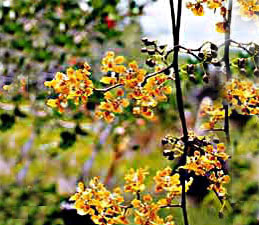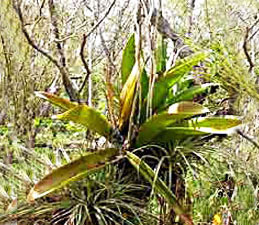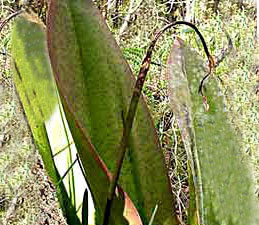Mule Ear Orchid New Fly Association
Mule ear orchid, Trichocentrum undulatum, is rare in the U. S. where it is only found in the Flamingo area of Everglades National Park. It grows in equally rare (probably) buttonwood forests. Although many plants live in this restricted area, only one flowered in 1998 (photo 1). Inflorescences do equally well in sun or shade but become yellower in full sun.

1. Mule Ear flowers, close-up of a long stalk.
We started following these orchids in the mid 1990's as although plants seemed plentiful in Coot Bay Hammock, a seaside hammock near Flamingo, the stalks of the inflorescences wilted away before flowering (photo 3). One year only two plants flowered of 200 we followed. Their habitat was the outer edges of the hammock with a prairie understory and scattered Buttonwood, Conocarpus erectus, overstory.
Photo 2 illustrates the typical green leaves of plants growing within the buttonwood (Conocarpus erectus) forest. They are epiphytic, often growing among air plants such as stiff-leaved wild pine, Tillandsia fasciculata, shown in photo 2 (to the lower left under the orchid). Plants are found high in trees or near ground level but all equally suffered the wilting disease. We decided to investigate the cause.

2. Healthy Mule Ear plant.
A literature search found that Dr. Frank Craighead, a retired entomologist who volunteered in the park during the early years thought the culprit to be a bark beetle (Xyloborus morstadti) which we questioned. By covering obviously infected flower stalks in plastic bags we eventually isolated a fly, Melanagromyza miamensis, that oviposites its eggs into the stalk where the larvae develop and feed on the interior tissue, causing the wilting observed in photo 3, later to emerge as adult flies. If ovipositing occurs below the 5th node, it usually kills the stalk. If entered above the 5th node, the plant generally develops side branches which may escape the seasonality of ovipositing. If this occurs the side branch may produce up to 6 flowers rather than 100 or so in the case of uninfected plants.
Photo 3 demonstrates flower stalk damage.

3. Mule Ear infected stalk.
Once we hatched the fly from a flower stalk an entomologist friend, Ron Clouse, forwarded it to the FL Dept. of Agriculture & Consumer Affairs, Div. of Plant Industry, Entomology Section for Identification. It created great interest in 1997 when we were in Peru's Amazon rainforest volunteering for Project Amazonas. To quote Nancy Coile of the Dept. ours was the "first sample for the insect museum (FSCA=Florida State Collection of Arthropods). FSCA is the largest insect museum in the South." The insect is very rare per Dr. Gary Steck their Diptera authority. They knew nothing of the fly's behavior and Dr. Steck has guaranteed publication if we would write up our research - an unfinished project. Hurricanes have ravaged the area in more recent years. We have not accessed the situation recently.